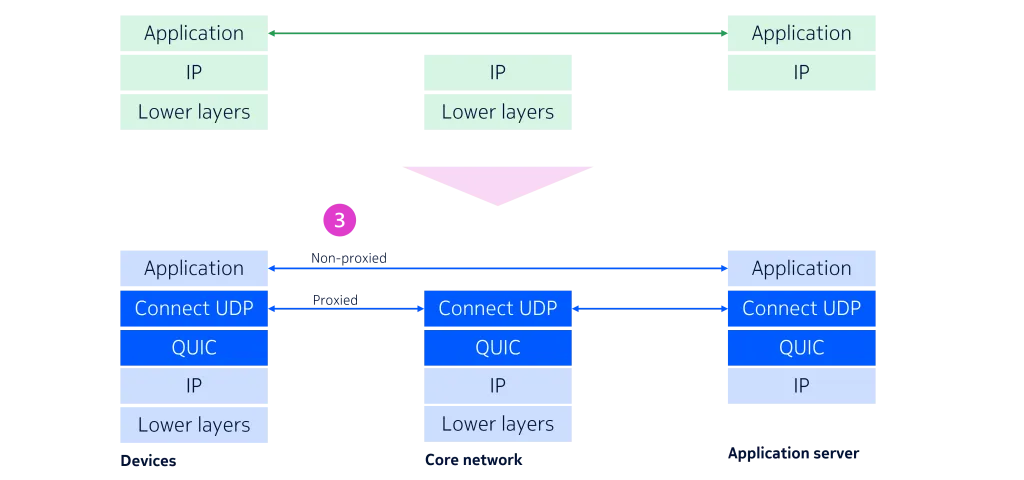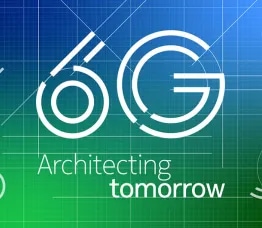Using modern transport protocols in 6G

The telecommunications industry is on its way to designing 6G. Nokia advocates for four key design principles for the 6G system architecture: simplicity, modularity, resiliency and service optimization. While building on top of the principal 5G architecture, we believe 6G can further take advantage from advancements in modern transport protocols defined by IETF. Leveraging related innovations, 6G can benefit from a simplified protocol stack and enhanced application-network interactions across diverse access technologies. Our goal is to treat internet traffic as a “first-class citizen” in 6G networks by keeping it secure and fast, while creating monetization opportunities for network operators.
Build upon the progress in IETF
OSI layer four (L4) transport protocols are essential parts of modern communications systems. IETF has been the protocol factory for various transport protocols for many decades. The User Datagram Protocol (UDP), known for its low-latency and minimal overhead, is often utilized for scenarios where speed is essential, though it sacrifices reliability. In contrast, the Transmission Control Protocol (TCP) provides reliable, ordered and error-checked delivery of data, making it suitable for applications where data integrity is critical. And Stream Control Transmission Protocol (SCTP), a protocol designed with signaling in mind, combines the advantages of both UDP and TCP, offering reliability, message-oriented communication, and multi-streaming capabilities. QUIC is a relatively new transport protocol, which provides end-to-end encrypted and integrity-protected communication. On top of that it enables faster connection setup, better congestion control, and mobility support via path migration and multi-path extension.
In 3GPP networks, efficient and reliable communication has the upmost priority. TCP, SCTP and even UPD play critical roles in meeting the diverse requirements of these advanced networks, each serving distinct roles in ensuring seamless end-to-end connectivity and performance. QUIC is already included in 5G network specifications for extended reality (XR) and media services as well as multi-access Protocol Data Unit (PDU) session connectivity services.
6G architecture improvement using transport protocol evolution
The Nokia view of the 6G system architecture has many commonalities with the 5G system architecture. However, to support new use cases and to achieve operational excellence, the system architecture needs to evolve, hence we now have opportunities to take advantages of the evolution of modern transport protocols that offer better support for reordering and packet loss, verbose feedback and better congestion control, low latency and low loss, better security, and more friendly to the cloud.

This is a non-exhaustive overview of potential areas where we believe that 6G can benefit from modern IETF transport protocols:
Simplified and cloud-friendly control plane transport protocol stack
Replacing legacy protocols like SCTP with QUIC as the control plane signaling protocol in the 3GPP interfaces would establish a simple but scalable end-to-end and cloud-friendly architecture for 6G. It reduces the need for complex Transport Network Layer Association (TNLA) handling between RAN and CORE, supports NATing, provides protocol security, and establishes end-to-end application nonce, which helps faster failure and recovery. It also provides a natural evolution of RAN and CORE interfaces and avoids the drastic changes of other proposed options (for example, service-based interfaces between RAN and CORE).

Performant SBA protocol stack
5G introduced service-based architecture (SBA) in the CORE network, and while the architecture is working well, there is room for improved performance. Some performance issues are related to how the HTTP/2 / TCP protocol is used and serialization is done. The use of HTTP/3 / QUIC in 6G could address some of the performance issues at the protocol layer. In Nokia, we are exploring this possibility by doing extensive performance evaluation. Switching protocols (TCP to QUIC, HTTP/2 to HTTP/3), can also bring synergies in the protocol stack for the RAN-CORE interfaces and service-based interface (SBI), which in turn would reduce the required expertise for maintaining those protocols, resulting in lower operational cost.

Robust encrypted traffic handling
Encrypted traffic is on the rise on the internet, especially for video traffic, which requires high bandwidth and low latency. While traffic encryption is expected and essential for communication security, it creates issues when providing quality of service (QoS) and traffic management in the network. To handle the encrypted traffic robustly would mean changing the typical assumptions regarding the traffic. Although 3GPP Release 19 started to handle encrypted XR and media (XRM) traffic by using RFC9298 (proxying UDP over HTTP – “connect-udp”), it still has some issues that need to be solved such as not being a natural fit to how Connect UDP was designed, error prone connection IDs (CID) to virtual CID mapping, and complex AF/AS interactions—and it only considers XRM services. While 5G paves the way, in 6G the aim is to handle the encrypted traffic for more generic cases to allow better encrypted traffic management.

Service optimization via in-band, on-path interaction
Service optimization is one of Nokia's four key design principles for 6G, that will be needed to handle the uptake of interactive service and application requirements. To boost the adoption of the exposure framework and support some QoS and policy enforcement cases, in-band, on–path interaction would be necessary. The goal is to allow in-band, on-path network interactions when the applications are authenticated and authorized via control plane methods using the network exposure function (NEF) and common API framework (CAPIF). IETF protocols like UDP proxying over HTTP, which are already implemented in the clients and servers, are good candidates for such in-band, on-path interactions.
Access independent enhanced service realization
6G will be more heterogenous than before and transport protocol features (loss recovery, reordering handling, congestion control, flow control, delay measurement, etc.) are important aspects for any service realization. To provide an enhanced end-to-end service over deterministic networking, multi-orbital NTN, and multi-access with 3GPP/non-3GPP accesses in 6G, the transport protocols need to be tuned to provide proper features and mechanisms (e.g., access specific congestion control, proxying support, and timeout periods).
Harnessing our ecosystem and industry leadership
Nokia holds a unique position in the market with a strong presence across multiple standards development organizations (SDOs), including the 3GPP, IETF, Broadband Forum (BBF), and IEEE. Our product portfolio strongly reflects this commitment to standards and enables us to drive the necessary changes. While 3GPP serves as the anchor for 6G standardization, enhancements and extensions to transport protocols must be addressed within the IETF. Additionally, BBF and IEEE standards need to evolve to support transport protocol features, such as L4S, for various access networks beyond 3GPP.
Given Nokia’s deep involvement in these SDOs, we are uniquely positioned to act as a mediator, ensuring that the best proposals from one organization are leveraged across others. This approach not only strengthens existing standards but transforms them into exceptional ones capable of meeting cross-organization requirements. By bringing together the best innovations from across these domains, we can architect tomorrow and design a network of the future that is impactful, intelligent, sustainable, secure and fast.





